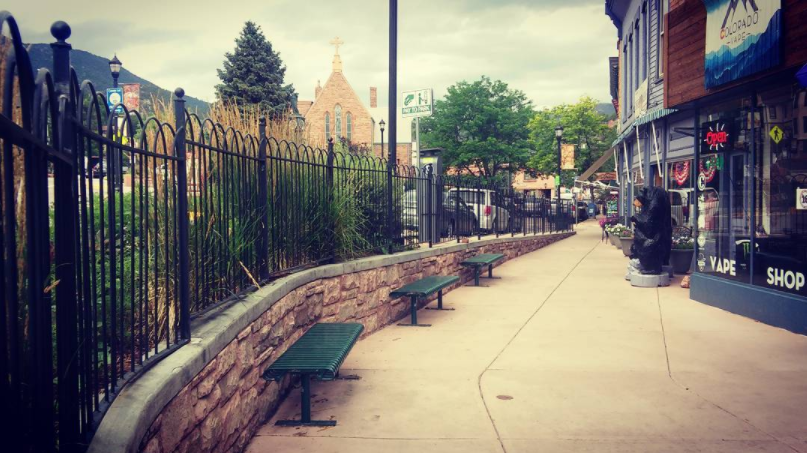A hotel remains unmoving while time passes in and around it. Technologies shift, fashion evolves, and social customs push forward in a slow but steady whir through its corridors and parlors, around its stately exterior, and between the branches of its shade trees. The people who move within it allow the hotel to collect artifacts and memories, to build a history that reflects the story of a place, of peoples both local and transitory, and in this microcosm, maps the history and culture of Manitou Springs.
History
The Cliff House began in 1873 as The Inn. The simple building was designed to accommodate travelers following promises of fortunes in Leadville, and other men who worked the nearby natural resources. When the draw to Manitou as destination for healing mineral waters really began to take hold in the 1880s, the town's mayor saw a business opportunity for expanding the property. He ultimately combined the purchase of the hotel with the 1914 addition of his own Mineral Bath Company. This would allow wealthy health seekers a reason to want to visit, and a luxurious hotel to stay in and hobnob while in Manitou Springs.
The hotel's reputation quickly attracted the world's elite, and thus paints a picture in time where current events intersected with Manitou's renown as a place to recover from tuberculosis. A prime example of this is the 1893 visit of Archduke Franz Ferdinand. The hotel, now refurbished, made for an ideal place for the Archduke to spend time as part of his world tour. He had set out the previous year from Vienna, publicly for a tour of the world's governments and customs, but also to regain his health after contracting TB. His diary for the two days he spent in Manitou didn't indicate this, rather it talked about his disappointment in the weather and not being able to trek to Pikes Peak. However, Manitou absolutely had a reputation as a health resort by 1893, and it is widely known he suffered from the disease and it affected his claim to the crown.
The porch of the Cliff House, 1889.
The Fire
During its brief run as an apartment building in the early 1980s, a dropped cigarette in the east turret started devastating fire. Much of the fourth floor was lost, and Cliff House was forced to close. In another reflection of what was occurring outside its doors, the devastation happened during "the worst economic downturn in the United States since the Great Depression." With no funding for the extensive repairs and no business, the doors remained closed until 1999, when it reopened as a grand hotel once again. The present day general manager notes in an interview with the Colorado Springs Business Journal that it was this fire that pulled the city of Manitou back to its present day level of tourism and retail economy. He says, "Strangely enough, the fact that he torched this hotel ended up setting up what is the new Manitou. Had he not done that, I don’t know if this would have ended up being a luxury property." The article continues, "Undergoing only a few swaps in ownership and business models, its resolution was seen, according to York, as a successful test run for higher-end establishments, catering to a new Manitou demographic, which in turn impacted the retail strip, and so on.
He said, for example, that contractor Chuck Murphy’s reconstruction of the Manitou Spa Building in the 2000s might never have been had the Cliff House fire and reconstruction not occurred.
'The most important buildings in Manitou spun off the Cliff House burning down,' he said."




Collecting History: Artifacts
In its 143 year history, The Cliff House has amassed the remnants of stories of thousands of people who have passed through its doors as staff, guests, and residents. History is the memory of things said and done, but artifacts are the hard evidence. The hotel has a wonderful display throughout the first floor detailing period clothing, guests lists, photos of workers from decades past, and bits that tell of the local economy; a bottle of spring water, ads from the local paper and brochures. The Cliff House has seen much happen in this tiny mountain town, and reflects back what tides of change bring through its many rooms and lounges.
Citations, Bibliography, Note
"History of The Cliff House at Pikes Peak." The Cliff House at Pikes Peak. Accessed 7/21/2017. http://www.thecliffhouse.com/about-cliffhouse/cliff-house-history
The Cliff House at Pikes Peak. Accessed 7/24/2017. http://www.thecliffhouse.com/location
Ferdinand, Archduke of Austria, Franz. "October 1, 1893," Franz Ferdinand's World Tour. Accessed 07/24/2017. http://www.franzferdinandsworld.com/manitou-1-october-1893/ p>
Ferdinand, Archduke of Austria, Franz. Tagebuch meiner Reise um die Erde, 1892-1893. Wien, Hölder, (1895-1896). No page number available.
"Cliff House Still a Manitou Anchor." The Colorado Springs Business Journal," accessed 07/24/2017. http://www.csbj.com/2015/03/24/cliff-house-still-a-manitou-anchor/
Mindich, Talia. "8 things you didn’t know about Franz Ferdinand," PBS NEWSHOUR. Accessed 07/24/2017. http://www.pbs.org/newshour/updates/8-things-didnt-know-franz-ferdinand/
Sablik, Tim. "Recession of 1981–82," Federal Reserve History. Accessed 07/25/2017. https://www.federalreservehistory.org/essays/recession_of_1981_82
Wagner, Kyle. "From food to service, Cliff House casts spell," The Denver Post. Accessed 07/24/2017. http://www.denverpost.com/2005/05/17/from-food-to-service-cliff-house-casts-spell/
Note: I included both the Ferdinand website translation and original German language publication separately as that is all that is available for research.



























